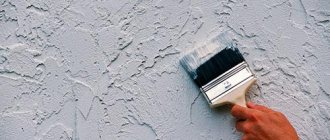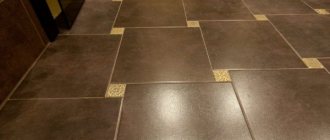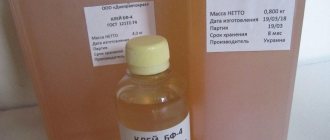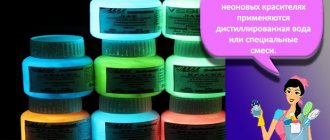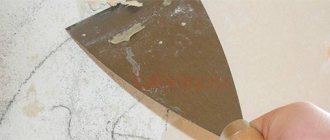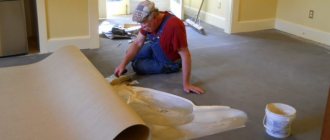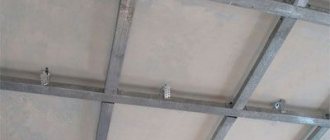Sasha asked a question:
I decided to lay the tiles in the kitchen myself, but I don’t want to spend extra money. At home there is a bag of cement left over from filling a hole in the garage. Please tell me how to make tile adhesive with your own hands so that it is no worse than the adhesive mixture from the store.
Tiler's answer:
Anyone who has planned a home renovation is trying to save on building materials and prepare an adhesive mixture for tiles with their own hands. I will tell you a recipe that I myself have repeatedly used for laying tiles.
In order to prepare tile adhesive you will need: a mixing container, a construction mixer, cement grades M-400 or M-500, sand, and plasticizers. I use PVA glue as plasticizers, but you can also use CMC wallpaper glue, washing powder, liquid soap or detergent.
Homemade tile adhesive
Homemade adhesives are still produced today, with a huge selection of various chemical compounds for attaching tile products from different materials with different weights.
This is caused by the need to use existing houses, previously purchased and unused building materials. You can make tile adhesive yourself to save money.
The result will be no worse than when using expensive mixtures, if we are talking about ordinary wall tiles of a standard size for interior decoration.
If you need to attach tiles (to the ceiling, drywall), or heavier porcelain tiles, you shouldn’t skimp on glue. Such materials were not used before.
Special glue is needed in rooms with high humidity and significant temperature changes (for example, a bathroom).
External finishing work requires frost-resistant, water-repellent mixtures that can also withstand strong temperature changes. There are special products for such conditions, and they need to be used.
Basic rules at work
It is not enough to simply choose the appropriate adhesive for gluing tiles; it is important to know some rules for working with it, namely:
- To ensure high quality of the solution, it must be made of the correct consistency (if prepared independently). This will ensure good and easy application to the surface;
- if the surface on which the tiles need to be glued is not too large, then you should not prepare a lot of mortar;
- Before starting work, it is important to clarify the “lifetime” of the finished composition. This will allow you to correctly calculate the portion of glue and not spoil the remaining material;
- you need to start preparing the adhesive for the tiles immediately before laying them;
- Ready-made formulations should not be left in open containers. You should always close the container with glue, preventing its contact with oxygen;
You need to apply a small amount of glue to the ceramic element, distributing it evenly over the surface with a special tool.
Features of modern tile adhesive compositions
However, there are different situations. During repairs, many people face financial problems, since not always everything can be foreseen in advance:
- The price of building materials is rising,
- Errors are allowed in calculating what is needed,
- Unforeseen expenses arise due to breakdowns,
- Hidden defects that need to be eliminated.
All this leads to the fact that there is not enough money or time to buy new equipment, but work needs to be done. Sometimes this is beneficial, strength and knowledge are mobilized and available means are used. This saves space (since they no longer need to be stored), time and money.
Homemade adhesive can be quite high quality. When making it, it is important to strictly observe the required proportions, work quickly, and prepare everything possible in advance to avoid premature hardening of the mixture.
Preparation of mastics
Diagram of a brick kiln.
Bitumen-latex mastic. Construction bitumen must be melted to a temperature of 160°C, then limestone flour is added to it and mixed. The resulting mass must be cooled to 70°C and a solution of latex and gasoline must be added to it and mixed thoroughly. You can use the mastic after it reaches room temperature. The percentage composition of the mastic is: construction bitumen - 49%, limestone flour - 24%, latex - 6%, gasoline - 21%.
Bitumen-turpentine mastic. The bitumen needs to be melted and Portland cement M500 added to it, mixed thoroughly until a homogeneous consistency is obtained. Cool to 70°C and add a mixture of latex, white spirit and turpentine, stirring carefully. The mastic is ready. Percentage composition of ingredients: construction bitumen - 65%, Portland cement - 5%, white spirit - 17%, turpentine - 8%, latex - 5%.
How to choose the best tile adhesive composition
The most common "homemade" tile adhesive can be prepared with:
- By adding PVA (polyvinyl acetate) or wallpaper glue based on CMC (carboxymethylcellulose);
- Liquid soap or washing powder;
- Paints.
In all cases, the above products are added to a mixture of cement and sand, in which one part cement and three sands (1:3). It is important to create a well-mixed substance with the consistency of thick sour cream.
When adding PVA, the glue must be diluted with water in a ratio of 2:1 - add one part of water to two parts of PVA. This compound is gradually poured into a pre-prepared container with dry cement and sand, stirring thoroughly.
When using liquid soap, you also need to prepare a solution: use 50 to 100 g of liquid soap per bucket of water. More than 100 grams of soap should not be dissolved, as efflorescence may form.
Carefully, stirring constantly, pour the resulting liquid into a container with a mixture of sand and cement, diluting it to the consistency of thick sour cream.
- You can add old, but still intact, paint to the mixture of sand and cement.
- You will have to be careful when working with paint-based glue.
- If it does not match the color of the tile, the tile must be laid without joints, avoiding paint showing through.
- Also, the work must be done quickly, avoiding premature hardening of the adhesive. The paint-based glue will be quite strong.
- In most cases, oil paint is used, but enamel is also acceptable.
- The latter dries out faster. This must be taken into account during work and speed it up as much as possible.
Using such simple recipes, you can make your own tile adhesive for laying tiles, saving money, as well as using unnecessary materials available at home, which would soon lose their qualities and would have to be thrown away.
Classification
All adhesive compositions can be divided into several groups depending on the main component from which they are made. Each group of compounds is described in more detail below.
Polyurethane
Features of polyurethane adhesive mixtures are as follows:
- characterized by a high degree of elasticity, capable of gluing any type of surface, even different ones, for example, glass and metal;
- used when necessary to provide additional waterproofing;
- some compositions are capable of expanding after hardening, therefore they are not always suitable for laying fragile ceramic tiles;
- characterized by high strength, elasticity and resistance to sudden changes in temperature.
There are one-component and two-component formulations. A one-component polyurethane adhesive hardens due to exposure to the environment and enters into a chemical reaction with air. Two-component compositions harden due to the combination of components after mixing in a certain ratio.
Cement
This type of glue can be found on sale in dry form in bags. The main composition is Portland cement, sand and modifying additives. Additives in glue are no more than 5%. Due to the sand, the glue is strong and at the same time has a low weight, which ensures a low load on the base.
Depending on the modifiers that are present among the components of the glue, its properties differ:
- when plasticizers are added, the solution becomes viscous and plastic;
- Due to antifreeze additives, a high level of frost resistance is achieved. Such adhesives are used for outdoor work;
- water-retaining additives do not allow moisture to evaporate and give the surface an increased level of strength.
There are two types of adhesive compositions based on cement:
- thin layer. Used in work where tiles are laid on a base with unevenness of no more than 1 cm;
- thick layer. They are used when it is necessary to level out differences of up to 3 cm on the basis, for example, if there is a need to tile the walls, then using cement thick-layer adhesive, you don’t have to do preliminary plastering and leveling the surface.
Important! Be sure to appreciate the level of elevation changes!
Dispersive
They are produced in the form of a paste-like homogeneous mixture, thick in consistency. Mix immediately before application. They can only be used on a flat concrete or plasterboard base that has been previously plastered.
With its help you can lay tiles both on the wall and on the floor. Their composition is an aqueous dispersion based on acrylic, latex or polyvinyl acetate.
Epoxy
The composition of the epoxy type of glue is resin and hardener. The components are mixed immediately before use. Thanks to the hardener, the mixture turns out durable and pressure-resistant, because the resin itself does not have such characteristics.
The main advantage of this type of material is its high level of adhesion.
Used for laying ceramic tiles on a wooden or metal surface.
Required qualities of tile adhesive
Ceramic tiles are quite heavy items. The glue for it must be good at gluing surfaces, which are often completely heterogeneous. In most cases they are vertical, which makes the work more difficult.
- The glue must have high adhesion, that is, quickly bond two surfaces.
- Tiles with high-quality adhesive do not move or fall.
- It has low fluidity and is resistant to slipping: the tile remains in the place where it was attached, there are no unwanted displacements.
The glue provides elasticity if it adheres well to the surfaces being glued. It should not dry out for a reasonable period of time so that slightly misaligned tiles can be straightened.
Sometimes you need to quickly spread a little more glue to finish the job. At the same time, it should be possible to correct the tiles laid last, which may slide slightly.
An adhesive that is made for tiles made from tiles and ceramic materials
It is quite possible to prepare the tile mortar yourself. to glue onto it without fear .
The composition of such a mixture must include:
- packaging of a foam plastic block 20x20x20 mm;
- acetone.
In order to stick a tile from a tile, you need to turn it over to the back side. Therefore, polystyrene foam is installed in the corners of the tiles and acetone is dripped onto each edge. Further, the tile composition has the ability to set by hand. This process occurs after a couple of seconds, due to the fact that polystyrene foam dissolves under the influence of the substances used. Likewise, the resulting mortar firmly adheres the tiles to the wall surface.
The method for preparing a solution for gluing walls with tiles takes into account similar elements as for tiles. However, here you need to prepare a specialized solution, which will have a ratio of 1:4 by volume. For more flexible parameters of the solution, lime must be added to its composition. It should be no more than 1/5 of the total volume.
You need to pay attention! It is completely forbidden to add gypsum to a cement solution, since the mixture will lose all its adhesive properties, and the tile lining will not adhere to the wall surface or floor.
Cement mortar, which is needed for installing tile coverings on walls
Profitable use of existing materials
Preparing tile adhesive is simple; it is only important to carefully observe the required proportions. As a result, you will be able to get the job done while saving money.
Making your own adhesive is also beneficial in cases where the tiles need to be installed on a not very flat surface. It is known that there is a thick-layer cement adhesive and a thin-layer one.
Thick-layer is also used to level the surface under the tiles. Its consumption is greater, so it is more profitable to dilute it from existing materials.
Knowing how to make your own tile adhesive is useful. This powerful product can be used for cosmetic repairs of premises, as well as for gluing other objects, without turning to specialists for help. At a small cost, everything in the house will remain beautiful and well-groomed.
Properties
Pool tile adhesive, intended for finishing the internal surfaces of the bowl (sides and bottom), has the following performance properties:
- high strength, resistance to mechanical loads;
- good adhesion to the base materials and the tile itself;
- elasticity, allowing the coating to withstand temperature and shrinkage changes in size;
- waterproof, lack of ability to absorb water;
- safety, absence of harmful emissions;
- good tolerance to contact with chemicals used to disinfect water and clean the bowl.
Specialized brands of glue are more expensive than regular ones, so the consumption of the compositions is also important. It should be as economical as possible, but without compromising the quality of tile laying.
Photo of the best tile adhesive
Solutions for laying tiles on the stove - from mixing by hand to preparing from a dry mixture
A stove or fireplace in a home becomes a key decorative element and helps create a feeling of warmth and comfort in the home. Stove facing tiles allow you to create different finishing options and organically fit the stove into an interior made in any style, from classic to high-tech.
But in order for the created beauty not to be destroyed for as long as possible, it is important to choose the right facing material and solution for the stove tiles.
When choosing a mixture, you should take into account the special operating conditions of the stove or fireplace (the surface gets very hot). This means that not only the tile, but also the glue that fixes it must have special fixing properties.
What solution do you use to lay the tiles on the stove? This is the question that will primarily interest the owner who has decided to make the lining of the stove with his own hands.
Solutions and mixtures for tiling stoves
The construction market offers many compositions for lining heated surfaces. But, we can distinguish three fundamental approaches to obtaining a solution, which have additional options.

